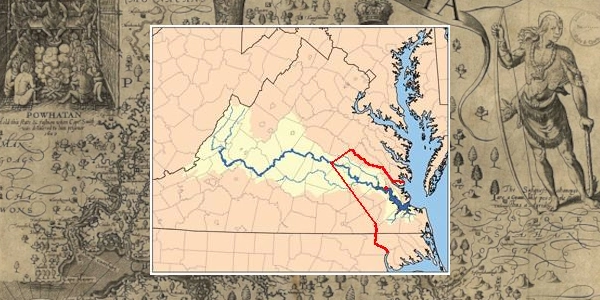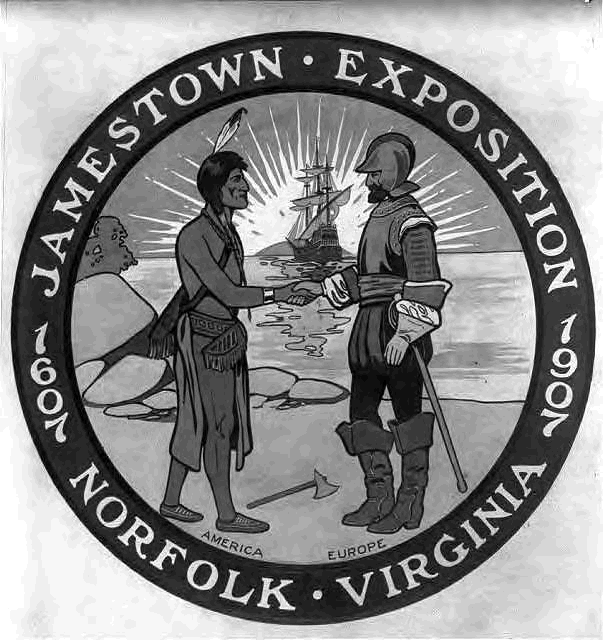Sponsor this page. Your banner or text ad can fill the space above.
Click here to Sponsor the page and how to reserve your ad.
-
Timeline
1644 Detail
April 18, 1644 - In the last Indian rebellion in the region, Opechanacanough and the Powhatan Indians attack the English at Jamestown, but their effort is repulsed and proves unsuccessful.

There had been twelve years of relative peace amongst the increasing number of settlers who were building plantations along both sides of the James River outside the fort. A palisade, barricade had been built at the top of the peninsula to thwart Powhatan attacks, and you would have thought that Opechanacanough, now in his old age, had enough of war. But the Second Powhatan War of 1622 and the subsequent years of conflict until the 1632 peace treaty were not enough. He still believed that if he inflicted enough tragedy on the new and old settlers that they would leave.
He used the same strategy as 1622, a surprise attack on the plantations and settlements outside the fort and palisade. Before he was done, Opechanacanough and the Powhatan warriors had killed even more of the Virginia Company settlers than in 1622, four to five hundred this time, although the outcome would be the same. Jamestown was spared and the colonial government furious. And yes, they had no more intent to leave after this horror than they had the two other times.
However, it did start another period of three years of war between the Powhatan and the settlers.

Specifics of the Peace Treaty and the Third Powhatan War
Attacks from both sides had been numerous for many years between 1622 and 1632. In 1624, eight hundred bowmen from the Powhatans under Opitchapam battled sixty colonists. Despite the disadvantage, the colonists won, destroying Indian cornfields and forcing the bowmen to retreat. There were assaults in 1627; a cease fire in 1628, and renewed hostilities from 1629, until the peace treaty was signed on September 30, 1632.
However, all the peace treaty got the Powhatans was more settlement on their lands; both sides of the James, on the Eastern shore, and south of the York. The palisade or stockade was built between the York and James River, about where Williamsburg is today. It was six miles wide.
"... a strong palisade ... upon a straight between both rivers and ... a sufficient force of men to defence of the same, whereby all the lower part of Virginia have a range for their cattle, near forty miles in length and in most places twelve miles (19 km) broad. The pallisades is very near six miles (9.7 km) long, bounded in by two large Creeks. ... in this manner to take also in all the ground between those two Rivers, and so utterly excluded the Indians from thence; which work is conceived to be of extraordinary benefit to the country," Captain Thomas Yonge, Jamestown, 1634.
How Opechanacanough and the Powhatan Confederacy lasted ten years after the palisades were built without either giving up altogether or making an earlier attack is unknown? Opechanacanough was probably in his nineties or one hundred when he made the attack on the exterior settlements on April 18, 1644. It was a coordinated effort. While there was no threat to Jamestown proper, between four hundred and five hundred colonists were killed in the outlying farms and plantations. The population of the colonists at the time was between eight and ten thousand.
The chief's aims were the same as in all their battles; to reestablish Native supremacy, correct the inappropriate behavior of the colonists squatting on their land, and to deter additional settlements. To thwart more attacks, the Virginia colony built four forts over the next two years; Fort Charles, Fort James, Fort Royal, and Fort Henry, near todays Petersburg. All private trade with the Powhatan was halted, although the Virginia Assembly allowed authorized trade for corn. They would have starved without it. And in August 1646, Governor William Berkeley captured Opechanacanough and deported he and his warriors to Tangier Island where a settler guarding him, killed him. Many of the other captives were sold into slavery.
Necotowance, who succeeded Opechanacanough, signed a peace treaty with the General Assembly of Virginia in October 1646. It stated that the tribes were now tributaries to the King and owed him a yearly stipend, twenty beaver skins. They were exempt from further taxation. A border was drawn where neither side could cross without a permit from one of the forts; the patent for the Virginia Company allowed additional settlement between the Blackwater and York River and up to the navigation points of the major rivers, i.e. James, etc. Settlements were also allowed north of the York River. The Powhatan must return all prisoners, including slaves, and turn in all guns.
The treaty and the succeeding decades effectively decimated the Powhatan Confederacy and the various tribes were absorbed into others by Bacon's Rebellion. Totopotomoi, who succeeded Necotowance, tried to work with the colonists, but was killed while fighting on the colonial side against other tribes. His wife Cockacoeske succeeded him as chief of the Pamunkey. Chief Wahanganoche of the Patawomeck attempted to work with the colonists, but they wanted more land, accused him of murder, of which he was acquitted by the House of Burgesses, but killed him on the way home from the trial.
Image above: Montage (background) Drawing by John Smith of the Virginia Territory around Jamestown, 1612, John Smith, Courtesy Wikipedia Commons; (inset) Vector drawing of the Virginia Colony Territory (outline in red, dot denoting Jamestown) and Powhatan Territory (colored in yellow), 2009, Til Eulenspiegel. Courtesy Wikipedia Commons. Image below: Montage (left) Drawing of 1622 Powhatan attack on Virginia settlers, 1628, Matthaus Meriam. Courtesy Wikipedia Commons; (right) Powhatan Indian Warrior, 1585, John White. Courtesy Wikipedia Commons. Info source: theclio.com; nativeamericannetroots.net; virginiaplaces.org; nativeheritageproject.com; Wikipedia.

History Photo Bomb

He used the same strategy as 1622, a surprise attack on the plantations and settlements outside the fort and palisade. Before he was done, Opechanacanough and the Powhatan warriors had killed even more of the Virginia Company settlers than in 1622, four to five hundred this time, although the outcome would be the same. Jamestown was spared and the colonial government furious. And yes, they had no more intent to leave after this horror than they had the two other times.
However, it did start another period of three years of war between the Powhatan and the settlers.

However, all the peace treaty got the Powhatans was more settlement on their lands; both sides of the James, on the Eastern shore, and south of the York. The palisade or stockade was built between the York and James River, about where Williamsburg is today. It was six miles wide.
"... a strong palisade ... upon a straight between both rivers and ... a sufficient force of men to defence of the same, whereby all the lower part of Virginia have a range for their cattle, near forty miles in length and in most places twelve miles (19 km) broad. The pallisades is very near six miles (9.7 km) long, bounded in by two large Creeks. ... in this manner to take also in all the ground between those two Rivers, and so utterly excluded the Indians from thence; which work is conceived to be of extraordinary benefit to the country," Captain Thomas Yonge, Jamestown, 1634.
How Opechanacanough and the Powhatan Confederacy lasted ten years after the palisades were built without either giving up altogether or making an earlier attack is unknown? Opechanacanough was probably in his nineties or one hundred when he made the attack on the exterior settlements on April 18, 1644. It was a coordinated effort. While there was no threat to Jamestown proper, between four hundred and five hundred colonists were killed in the outlying farms and plantations. The population of the colonists at the time was between eight and ten thousand.
The chief's aims were the same as in all their battles; to reestablish Native supremacy, correct the inappropriate behavior of the colonists squatting on their land, and to deter additional settlements. To thwart more attacks, the Virginia colony built four forts over the next two years; Fort Charles, Fort James, Fort Royal, and Fort Henry, near todays Petersburg. All private trade with the Powhatan was halted, although the Virginia Assembly allowed authorized trade for corn. They would have starved without it. And in August 1646, Governor William Berkeley captured Opechanacanough and deported he and his warriors to Tangier Island where a settler guarding him, killed him. Many of the other captives were sold into slavery.
Necotowance, who succeeded Opechanacanough, signed a peace treaty with the General Assembly of Virginia in October 1646. It stated that the tribes were now tributaries to the King and owed him a yearly stipend, twenty beaver skins. They were exempt from further taxation. A border was drawn where neither side could cross without a permit from one of the forts; the patent for the Virginia Company allowed additional settlement between the Blackwater and York River and up to the navigation points of the major rivers, i.e. James, etc. Settlements were also allowed north of the York River. The Powhatan must return all prisoners, including slaves, and turn in all guns.
The treaty and the succeeding decades effectively decimated the Powhatan Confederacy and the various tribes were absorbed into others by Bacon's Rebellion. Totopotomoi, who succeeded Necotowance, tried to work with the colonists, but was killed while fighting on the colonial side against other tribes. His wife Cockacoeske succeeded him as chief of the Pamunkey. Chief Wahanganoche of the Patawomeck attempted to work with the colonists, but they wanted more land, accused him of murder, of which he was acquitted by the House of Burgesses, but killed him on the way home from the trial.
Image above: Montage (background) Drawing by John Smith of the Virginia Territory around Jamestown, 1612, John Smith, Courtesy Wikipedia Commons; (inset) Vector drawing of the Virginia Colony Territory (outline in red, dot denoting Jamestown) and Powhatan Territory (colored in yellow), 2009, Til Eulenspiegel. Courtesy Wikipedia Commons. Image below: Montage (left) Drawing of 1622 Powhatan attack on Virginia settlers, 1628, Matthaus Meriam. Courtesy Wikipedia Commons; (right) Powhatan Indian Warrior, 1585, John White. Courtesy Wikipedia Commons. Info source: theclio.com; nativeamericannetroots.net; virginiaplaces.org; nativeheritageproject.com; Wikipedia.






